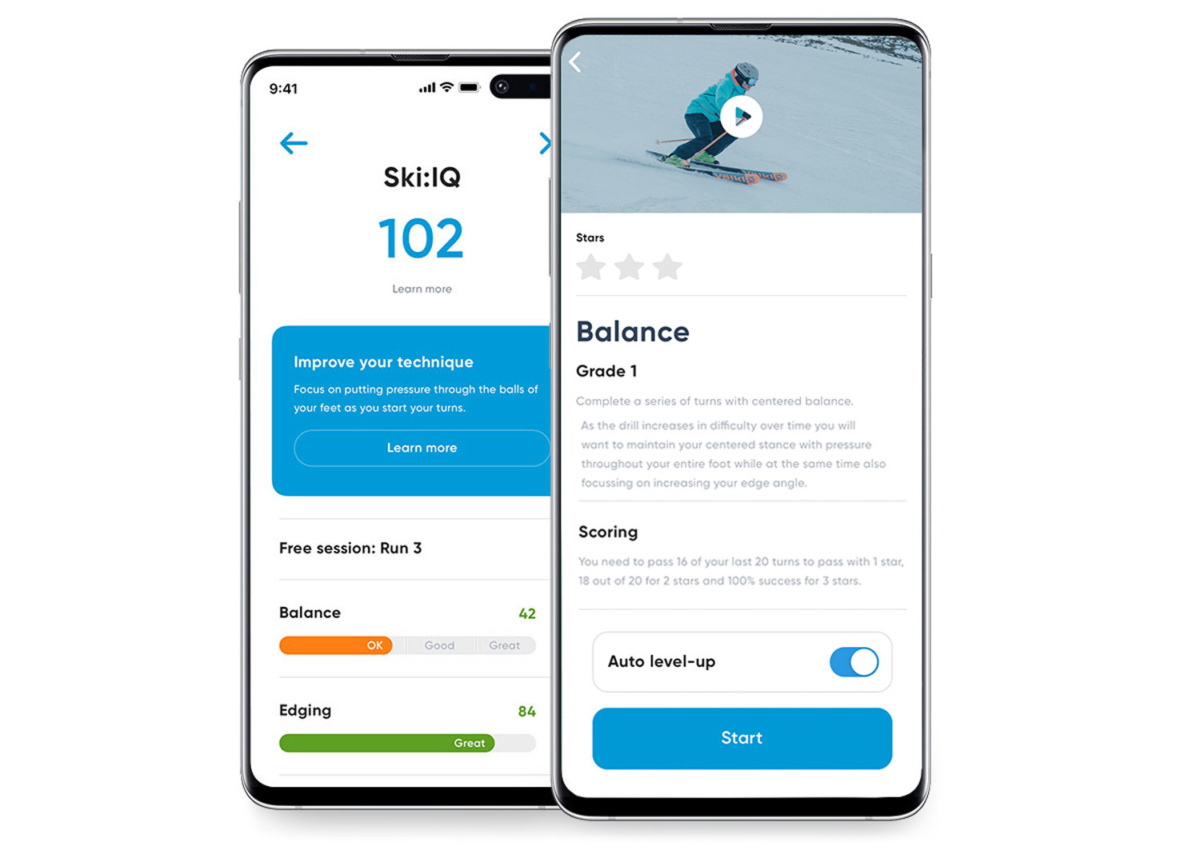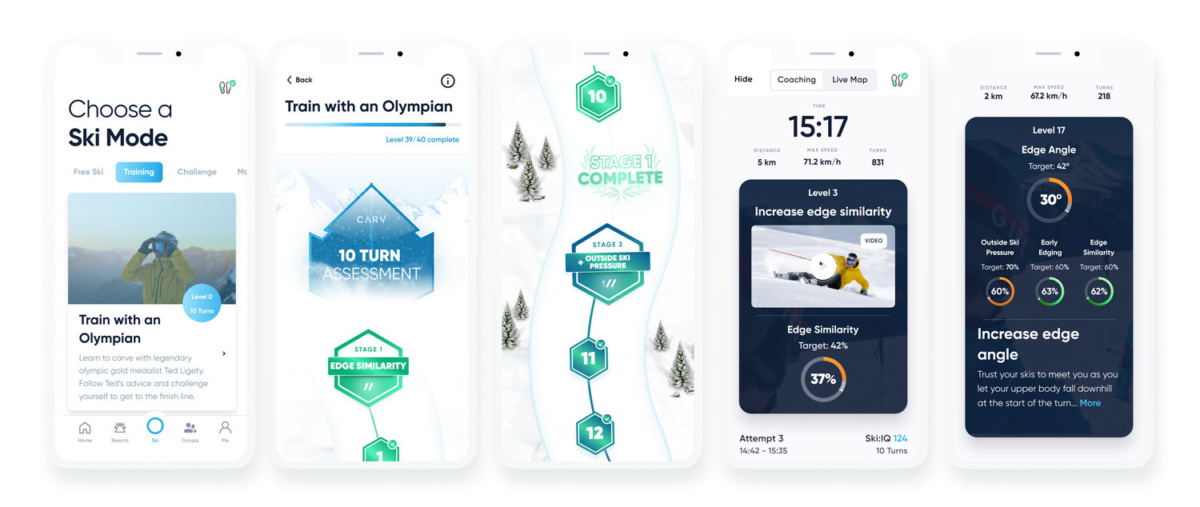Carv Labs: Why We're Developing Active Coaching

Votes:
This summer we’ve spent lots of time thinking about how we can take Carv’s coaching a step further. Charlie (our Lead Data Scientist) and the team have spent years dialling in the accuracy of the Ski:IQ scoring system, and we’ve built different levels of coaching interaction into our different Modes (Free Ski, Training, Challenges, Monitors). Our members can choose how much feedback they want and if they want it now, while skiing, or afterwards on the chairlift.
But we know our current product isn’t perfect. Carv is totally unique to other learning apps or games because your skiing ability is so greatly influenced by the slope you are skiing on, meaning that traditional game design tactics and levels just don’t apply. This means that our current training is optimized for when you’re skiing the perfect, wide-open empty groomer which - to be honest - comes less often than snowstorms in the Sahara.
How real-time coaching was born
Before getting into why we’re building Active Coaching Mode, let’s start with some Carv history. When Jamie and Pruth (our co-Founders) first dreamt up the idea of digital ski coaching, one of their key coaching philosophies was establishing a quick feedback loop so skiers can learn and improve faster than most of us do in a traditional ski lesson.
The idea for real-time audio feedback came about when Jamie skied with Austrian Ski Instructor Klaus Mair. Klaus has pioneered a type of radio coaching where he follows you as you ski and gives you real-time tips and feedback via radio. That way you can respond to feedback and adapt your technique on the fly, rather than waiting until you both stop on the side of the run or on the chairlift. That run stuck with Jamie, and he knew he wanted to develop digital coaching with a similar real-time element.
Want to get your hands on Carv first next season?
Jamie and Pruth applied this principle to digital coaching and used it to create our real-time training modes. This feedback after every turn is Carv’s secret sauce that shortcuts muscle memory. It allows you to get creative with your technique to learn what good actually feels like which is something no coach could ever do. The goal of Active Coaching Mode is to give this real-time feedback more often but also make sure it’s relevant to your context.

Here’s what Balance Training looked like when we introduced it back in 2019. Our User Experience design has come on a bit since!
Using game design to improve faster
Games are increasingly a powerful source of inspiration for us. We learn best when we’re relaxed and having fun. Games have cracked this with mechanisms that engage and frequently reward you - keeping you in the flow state. What does the flow state look like in skiing?
We asked our good friend ChatGPT to describe ‘flow state’ in the style of a freestyle skier.

There’s a reason that people will spend hours developing incredible skills at Fortnite or Need for Speed.
This guy has got so hooked that he’s taken the idea of ‘custom racing setup’ to a whole new level!
What makes games so addictive? And how can we bring that process into Carv? These are the questions we’ve been exploring as we’ve been looking to game design to improve our real-time coaching.
When we developed Training Modes, we borrowed the concept of leveling-up from game design. The first iteration of Training was structured so that if you passed a certain threshold (for example an edge angle of at least 40 degrees) for 16/20 turns you made it to the next level.
Take a quick look at how our Training Modes work in real life!
This created super addictive gameplay that keeps you wanting to progress further, helping you improve faster. But we only had 10 levels, and that created 2 problems.
Firstly, because there were only 10 levels to cover the whole scope of ski ability, from beginner up to expert, the gaps between levels were quite large! You might quickly clear level 4, and then become stuck on level 5 for a long while. That doesn’t feel good or motivate you to improve!
The second problem was that only 10 levels equates to relatively few ‘level-up’ moments. These are key to reinforcing your enthusiasm to improve and motivating you to beat the next level. The small change of moving to 20 levels had a big impact and kept our skiers encouraged much more effectively. We saw the average improvement increase, but there were still improvements that we could make. We hear from skiers on short hills that squeezing in 20 turns can be tough or even impossible in some resorts.
So we jumped at the chance to push this format forward last year as we partnered with Ted Ligety because we see it has so much potential.
There’s a lot in a beep
If you’ve been with us from the start, you may remember our ‘negative’ sound when you failed a turn in one of the first versions of Training Mode. In this early iteration, offering a negative sound was clearly powerful, but not in the right way. Some of you even told us you wanted to throw your phone off a cliff when you failed a turn. Luckily, we took that feedback on board and moved to a more neutral sound. But we quickly learned not to underestimate the power of sound design.
When we released Train With An Olympian in November in partnership with Olympic Champion Ted Ligety, we created our most powerful experience yet. We spent a long time with Ted on the structure of the mode, landing on a system of 40 levels which sequentially build on 4 core carving metrics (Edge Similarity, Outside Ski Pressure, Early Edging, and Edge Angle), so you felt rewarded as you progressed onto a new skill every 10 levels. Within each level, instead of requiring 16/20 turns above target as in Training Modes, we switched to 10 consecutive turns - making a faster level-up with more level-up events.

Train with an Olympian guides you through 40 levels, styled in the app as a ski run. To pass each level, reach the metric targets on 10 turns in a row.
But it’s the sound design that set this mode apart. We added a rising chromatic sound so that after every successful turn the pitch of the tone would get higher, so you feel the jeopardy and hunger to win. And we added some more human interaction with snippets of wisdom from Ted in the form of audio anecdotes. You reflected back to us in the Carv Skiers’ Community and to our Customer Success team that this mode was very powerful, and we’ve seen it become our most used mode besides Free Ski.
Ted Ligety takes you through why we built Train with an Olympian
What’s Next? Active Coaching
We’ve been listening to your feedback and are pushing to keep improving our coaching beyond Train with an Olympian. Despite the success of the mode, we see repeat playability as an issue to solve. Some skiers reported getting stuck when they reach their limit or plateau, and needing perfect conditions in order to push to further levels.
We’ve started building Active Coaching Mode to take our real-time feedback and the gamified elements of Training Modes and Train with an Olympian, and apply them to a new system with more dynamic coaching. What does this mean?
Our goal is to create a system that adapts to your skill level, not just at the start but also as the conditions change or you get tired throughout the day. It would be fun to play and allow you to level up no matter the snow conditions. We’re also looking to dynamically adapt it to your focus areas, so coaching is based on the areas you need to work on the most.
We’ve been playing with dynamic coaching types like this in alpha builds on snow for a while, and this summer we’ve started to build it for you. We’re still in the early stages of development, but here are the principles we’re focussed on:
Levels should adapt around the context of the skier (skiing isn't like tennis, the court changes all the time!). We want to make a learning tool that’s still fun to play even if the conditions are more challenging.
It should be more rewarding to play. We aim to build on the jeopardy and hunger to win that we’ve created in Training Modes and refined in Train with an Olympian so that Active Coaching Mode feels exciting and engaging to play.
By adapting the difficulty to your changing context we are able to create a game that is fun to play without getting so frustrated that you want to throw your phone off a cliff. We are focused on not only building a mode that can be played all day but one you want to play all day.
Carv Team member Damian gives his feedback on an initial prototype of Active Coaching Mode.
Active Coaching Mode has been an idea I’ve been toying with for the last 2 years but now is finally the season where the conditions are perfect for its success. We have a dynamic system that adjusts the difficulty to your context as well as a novel new way to interact with Carv (more on this in a future article) and a super motivating game that makes it fun to play all day. Combining user-driven learning with gamification tactics has created what we believe is the most powerful coaching tool we’ve ever created.
We have also leveraged the revolutionary power of AI and language learning models to create much more natural-sounding feedback which is personalized to you and what you have just done. And for anyone who is getting fed up with the, at times, robotic voice then boy do we have something exciting in the works for you.
We are spending this summer building, testing and iterating to make the most playable, dynamic and intelligent coaching tool Carv has ever built. If you are lucky enough to be skiing in the Southern Hemisphere from July to August and want to get involved in our Beta testing program then get in touch, we’d love to have as much feedback as possible.